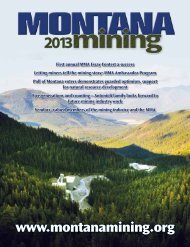2009 Montana Mining - Montana Mining Association
2009 Montana Mining - Montana Mining Association
2009 Montana Mining - Montana Mining Association
Create successful ePaper yourself
Turn your PDF publications into a flip-book with our unique Google optimized e-Paper software.
Barretts Minerals Inc.<br />
uses an ancient resource<br />
for modern applications<br />
Early Native Americans discovered talc, commonly called soapstone,<br />
in the Ruby Mountains of what is now southwest<br />
<strong>Montana</strong>. Local tribes mined it for their own use, including trading<br />
with other tribes; and, the Lewis and Clark journals even mention<br />
smoking a peace pipe made from this easily carved rock when they<br />
navigated the waters of the Beaverhead River in 1805 and camped by<br />
Rattlesnake Cliffs.<br />
The talc mining tradition in the Ruby Mountains started by the early<br />
Native Americans is still carried on today, at Barretts Minerals Inc.<br />
(BMI), which extracts the talc from two mines in the Ruby Mountain<br />
Range and processes it along the banks of the Beaverhead River south<br />
of Dillon, <strong>Montana</strong>. Although artists still produce carvings from this<br />
talc, it is now also used in many industrial and consumer applications<br />
such as paints, plastics, ceramics and health-care products. Though<br />
talc (Magnesium Silicate Hydroxide) is the world’s softest mineral, it<br />
has very little chemical reactivity – it is practically insoluble in water,<br />
weak acids or alkalis, and has a melting point of 1,500o C. These char-<br />
52 <strong>Montana</strong> <strong>Mining</strong> <strong>2009</strong><br />
acteristics make the mineral ideal for ceramic applications, such as the<br />
substrate used to encase precious metals like the platinum in catalytic<br />
converters, which reduce automobile pollution; indeed, a good portion<br />
of the talc mined at Barretts Minerals is sold for this purpose.<br />
“The catalytic converters of the majority of automobiles manufactured<br />
in North America – and a great deal of those worldwide – contain<br />
talc from the Treasure and Regal Mines. So most of the people in<br />
this country are driving around with talc from our mines,” says Jim<br />
Daley, plant manager at Barretts.<br />
The mineral is also an excellent filler and extender; used in paints<br />
to improve coverage, in plastics for reinforcement, and for use in what<br />
is known as an “antiblock” to reduce static cling in plastics wraps and<br />
bags, it is also utilized in various products such as body powder, and<br />
as a coating on tablets and chewing gum. Since the <strong>Montana</strong> talc has<br />
a platy structure it does not have the health risks associated with other<br />
minerals that could be used for these applications.<br />
Electron Micrograph scan showing the platy structure of BMI talc.



